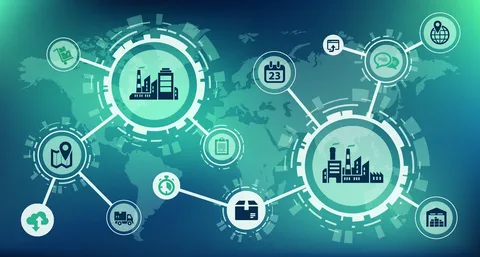We have to accept the facts: supply networks aren’t what they used to be. Companies used to be able to get by with just spreadsheets, gut feelings, and a few reliable suppliers. Those days are over. Today’s global supply chains are complicated, cover a lot of ground, and are more likely to be disrupted. It’s evident that resilience isn’t a luxury anymore; it’s a must. Pandemics, political tensions, natural disasters, and cyberattacks are all examples of this.
At the same time, there is more and more demand to be environmentally friendly. People who buy things, create laws, and even invest want to know who is in charge. People want to know the origins of something; how it is made, and what impact it has on the environment.
So, how do we go about solving both of these—is it resilience or sustainability?—without having to put a lot of stress on our budgets or operating bases?
When they come together, blockchain, Internet of Things (IoT), and artificial intelligence (AI) present a triad of technologies that could massively overhaul how supply chains work.
Why Supply Chains Need a New Look
Let’s talk about why supply chains need to change in the first place.
For example, look at the COVID-19 epidemic. It showed how weak the world’s supply chains actually are. Parts were delayed in one country because of a lockdown in another. The Suez Canal obstruction, chip shortages, and rising gasoline prices make it evident that “just-in-time” methods aren’t working anymore.
Climate change is no longer something we can ignore. More than 90% of a company’s greenhouse gas emissions come from its supply chains. And others who have a stake in the matter are paying attention. Customers are choosing brands that perform responsibly, and governments are making rules stricter.
It’s hard to find the right balance between making systems that can swiftly recover from problems and being socially and environmentally responsible. That’s where AI, IoT, and blockchain come in.
AI: The Smart Assistant for Your Supply Chain
Artificial intelligence might sound like something from a science fiction movie, but in supply chain management, it’s all about making decisions that are better and faster.
Predictive Analytics: Imagine being able to see a delay coming before it happens. AI looks at weather patterns, political news, social media, and past trends to figure out what might go wrong in the supply chain. You can change the route of shipments, change the amount of stock you have, or discover new suppliers before the crisis hits.
Demand Forecasting: If you have too many things, you will be wasting them, while too few things will enraged customers. AI, therefore, watches purchase patterns, seasonal trends, and even events occurring in neighboring localities for better planning by businesses. Thereby, when stock-outs occur less often and waste less, one is hence running a leaner business.
Smart Automation: For issues that are repetitive in nature, such as order processing or invoice matching, AI would automate the process, freeing up your firm’s resources for strategy work instead of paperwork.
Tip: Start with small things. You don’t have to put in a whole AI system all at once. Start with one area, like forecasting or warehouse planning, and then add more areas as you go.
IoT: Making Data Useful Right Away
The Internet of Things is like the brain of your supply chain. It connects real-world things like pallets, trucks, and containers to the digital world.
Sensors with GPS can tell you exactly where your things are at any given time. You will know why a shipment is late and how to fix it if it is.
Condition Monitoring: Temperature and humidity sensors can tell you if the storage conditions for sensitive items like food or medications fall outside of the regular range. That might be the difference between a safe delivery and an expensive recall.
Preventive repair: The Internet of Things (IoT)-connected machines can alert you when they require repair. This helps keep your supply chain running smoothly by stopping unexpected breakdowns.
Smart meters in warehouses or factories help you keep track of how much energy you’re using and find ways to save costs or emissions.
A real tip: Use IoT not only to keep track of things but also to make sure they are following the rules. As rules get stricter about food safety, pollution, and ethical sourcing, IoT data can help you be ready for an audit.
Blockchain: Trust Is Built One Block at a Time
People typically think of blockchain as just bitcoin, but what makes it so useful for supply chains is that it makes everything clear and easy to find.
Immutable Records: A sturdy and tamper-resistant digital ledger would keep records of every transaction, every movement, and every change in condition. In that regard, suppliers, manufacturers, and logistical partners need to be more accountable.
Provenance Tracking: Do you need to demonstrate the environmentally friendly cultivation of your coffee beans? Or that the leather you buy originates from farms that are beneficial for the environment? You can follow every step of a product’s journey with blockchain, even the raw components.
Smart contracts are digital agreements that carry out their terms automatically when certain criteria are satisfied. For instance, a supplier immediately gets paid as soon as the goods are delivered and checked. That cuts down on arguments and speeds up deals.
Real advice: You don’t need to start from the beginning. There are existing blockchain networks for certain industries, such as IBM’s Food Trust for food and VeChain for luxury items.
The True Power: AI, IoT, and Blockchain all have their advantages. But what about together? Together, they create a strong feedback loop.
Imagine this: A shipping container has an IoT sensor that picks up a rise in temperature. An AI system looks at the data and figures out how likely it is to spoil. It then suggests sending it to a distribution center that is closer. Blockchain keeps track of every stage of this occurrence, from the first spike to the decision to reroute. The data makes it easy for regulators and other interested parties to see what’s going on.
This process isn’t just about being more efficient; it’s about knowing what’s going on in the supply chain.
A Quick Check of Reality
We shouldn’t act like this is a change that happens in a snap. It takes effort, money, and change management to use these technologies. Employees will need training, and old systems may need to be updated.
But the good news is? You don’t have to accomplish everything all at once.
Please select one problem to address first. It may be making deliveries more reliable, cutting down on waste, or making it easier to track things. Pick the technology that works best for that challenge, and then build on it.
Last Thoughts
Strong, long-lasting supply chains are now about beating the competition, not just staying in business. Businesses that can deal with problems and reach their sustainability goals will earn customers’ trust, work more efficiently, and stand out in crowded markets.
AI helps you make plans and guess what will happen.
IoT lets you see and hear what’s going on.
Blockchain makes your data more trustworthy.
They can work together to make your supply chain more proactive, more open, and less wasteful.
Things are changing quickly in the world. If your supply chain cannot adapt, it may fall behind.
Are you ready to make your supply chain ready for the future?
Find the weak links first, and then let technology assist you in making them stronger.



